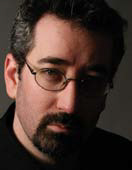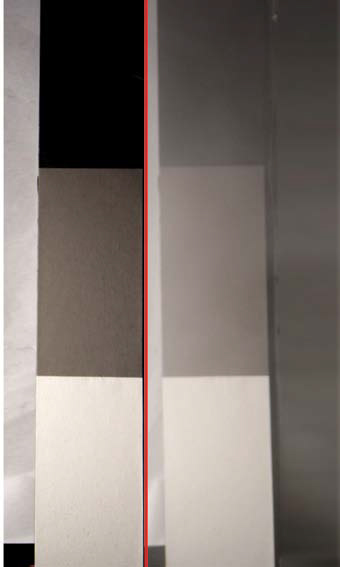Using a Light Meter to Maintain Atmosphere

Jay Holben
In last month’s column I talked about the importance of a light meter, even in today’s digital age, as well as explaining how meters function. To expand on that thought, I wanted to share a technique I developed over the years utilizing a reflected light meter to maintain a consistency of fog or atmosphere in a location over time.
A BLACK FLAG
Many cinematographers like to use fog or haze to help add atmosphere and reduce contrast. Maintaining a consistent level of atmosphere however, can be an enormous challenge. Back in the stone ages, when I was a gaffer, I developed a methodology for maintaining that consistency with excellent accuracy.
Since fog or haze adds particulates in the air that reflect and/or refract light, the way to maintain the proper level of atmosphere is to measure that scattering of light. I would do this by placing a black flag in an unused portion of the set or location, but within sight of the camera. It’s best to put the flag in a dark corner, away from activity. Often the best place is behind camera, or perpendicular to the lens. You want the flag to be at a distance from you, but as close to the photography area as possible without being in the way.

In this image the beam of light from this Arri Fresnel is visible because of fog in the air. Light refracts and reflects off the individual moisture particles in the air. This effect is most pronounced when you backlight the atmosphere. I put the flag up perpendicular to the ground, but flat to my position at the camera. Then I take a “Tweenie” or similar small, focusable light, and put it on the floor in front of the flag with the light beam shooting straight into the air. Using barn doors on the light, I cut the light off of the flag so that the light path is passing in front of the flag, but not touching it.
It’s also important that the light from the Tweenie isn’t bouncing off the ceiling back into the metering area. If you’ve got a white ceiling, then it’s best to use another flag above your existing flag to block/ absorb the light and eliminate bounce.
Since the light beam is passing in front of the flag, when there is no atmosphere in the air, you cannot see the light path. The more fog or haze you put in the air, the more defined (brighter) that beam of light will be. Simply taking spot meter readings of the black flag behind the light beam will allow you to determine how much atmosphere is in the air at any given time.
The professional video industry's #1 source for news, trends and product and tech information. Sign up below.
CHECKING THE ATMOSPHERE
From my position at the camera, I can use a reflected light meter to take a reading of the black flag. When there is no atmosphere in the air, the reflected reading should be zero. I shouldn’t be getting any bounce back off the black flag. When I start to put fog or haze into the air, it’s going to scatter the light coming from the Tweenie on the floor. I can now take a meter reading of that light beam in front of the black flag. The more fog/haze in the air, the brighter that reading is going to be.
When I’ve set the level of atmosphere that looks good to me on the set, I then take a reading of the light at the flag and note the reading. Let’s say that’s an f/4.

A demonstration of loss of contrast through use of fog: on the left is a grayscale of black, medium gray and white color chips in normal conditions. On right is the same grayscale with the use of fog. The more fog is in the air, the more the light is scattered and the less contrast is seen. This happens, primarily, in the backs and mids, with the highlights being effected the least. Then we shoot the take.
By the time we get to the next take, the level of atmosphere has—most likely— changed. Air current from people moving around, air leaks in the location or set, air conditioning, doors opening and closing, open windows, vents, all of these things will alter the atmosphere. When we’re ready for the next take, I take a quick reading of the flag. If my reading is, say, f/2.8, I know my atmosphere is too low and we have to add in more. If my reading is f/5.6, I know I’ve got too much and we’ve got to let it dissipate a bit before we shoot.

Setting up a black flag and light below it allows for the ability to maintain atmospheric levels. When there is no fog (left) the meter will read nothing off the light beam passing in front of the black flag. As you introduce more and more atmosphere (center and right) the meter will read more reflected light from the fog in the path of the light in front of the flag. The more fog you have in the air, the higher the light reading will be. If you really have to be incredibly accurate with the atmosphere, it’s best to have multiple flags set up at different points in the location. It’s possible to hide these little metering zones within the set as well, you just have to be more creative about where you put them. Also, be sure that the flag is big enough to cover your degree of spot meter with plenty of safety room— you don’t want to be accidentally getting light values from something behind the flag biasing your control.
Utilizing this relatively simple technique, I have been able to maintain very accurate control over atmosphere in scenes in many different applications.
Jay Holben is the technical editor of Digital Video and a contributor to Government Video. He is also the author of the book “A Shot in the Dark: A Creative DIY Guide to Digital Video Lighting on (Almost) No Budget.”
